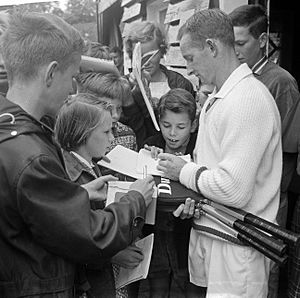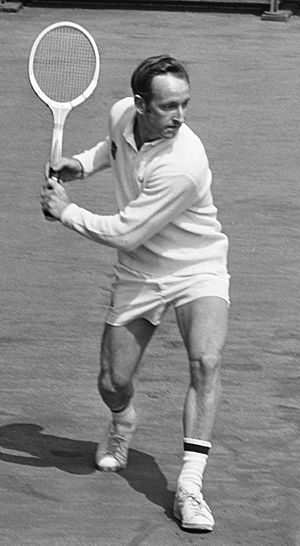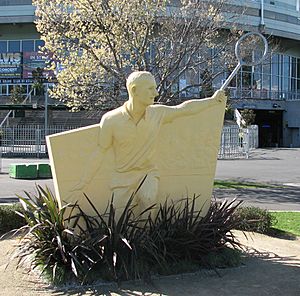Rod Laver facts for kids
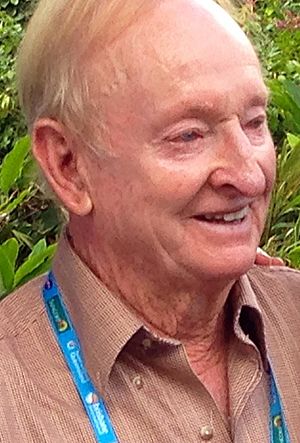
Laver in 2015
|
|
| Full name | Rodney George Laver |
|---|---|
| Country (sports) | |
| Residence | Carlsbad, California, U.S. |
| Born | 9 August 1938 Rockhampton, Queensland, Australia |
| Turned pro | 1963 (amateur tour from 1956) |
| Retired | 1979 |
| Plays | Left-handed (one-handed backhand) |
| Prize money | US$1,565,413 |
| Int. Tennis HoF | 1981 (member page) |
| Singles | |
| Career record | 1689–538 (75.84%) in pre Open-Era & Open Era |
| Career titles | 200 (72 open era titles listed by ATP) |
| Highest ranking | No. 1 (1961, Lance Tingay) |
| Grand Slam singles results | |
| Australian Open | W (1960, 1962, 1969) |
| French Open | W (1962, 1969) |
| Wimbledon | W (1961, 1962, 1968, 1969) |
| US Open | W (1962, 1969) |
| Other tournaments | |
| Tour Finals | RR – 2nd (1970) |
| WCT Finals | F (1971, 1972) |
| Professional majors | |
| US Pro | W (1964, 1966, 1967) |
| Wembley Pro | W (1964, 1965, 1966, 1967) |
| French Pro | W (1967) |
| Doubles | |
| Career record | 235–77 (75.32%) |
| Career titles | 28 |
| Highest ranking | No. 11 (per ATP) |
| Grand Slam doubles results | |
| Australian Open | W (1959, 1960, 1961, 1969) |
| French Open | W (1961) |
| Wimbledon | W (1971) |
| US Open | F (1960, 1970, 1973) |
| Mixed doubles | |
| Grand Slam mixed doubles results | |
| Australian Open | F (1959) |
| French Open | W (1961) |
| Wimbledon | W (1959, 1960) |
| Team competitions | |
| Davis Cup | W (1959, 1960, 1961, 1962, 1973) |
Rodney George Laver (born 9 August 1938) is an Australian former professional tennis player. Many people consider him one of the greatest tennis players ever. He was ranked the world number 1 for five years in a row, from 1965 to 1969. He also held the top amateur spot in 1961 and 1962.
Laver won an amazing 200 singles titles in his career. This is more than any other tennis player in history. He won 11 major Grand Slam titles and 8 professional major titles. He achieved the Grand Slam twice. This means he won all four major tournaments in the same year. He did this in 1962 and again in 1969. His 1969 Grand Slam is the only time a male player has done this in the Open Era of tennis.
Rod Laver won titles on all types of tennis courts. These included grass, clay, hard, carpet, and wood courts. He also helped Australia win the Davis Cup five times. The Rod Laver Arena in Australia, where the Australian Open is held, is named after him. So is the Laver Cup tournament.
Contents
Rod Laver: A Tennis Legend
Early Life and Beginnings
Rodney George Laver was born in Rockhampton, Australia, on August 9, 1938. He was the third of four children. His father, Roy Laver, was a cattleman and butcher.
Rod left school as a teenager to focus on his tennis career. He was coached by Charlie Hollis and later by Harry Hopman. Hopman was the Australian Davis Cup team captain. He gave Rod the nickname "Rocket."
Amazing Career Achievements
Amateur Years (1956–1962)
Laver became both the Australian and US Junior champion in 1957. He became famous in 1959 at Wimbledon. He reached three finals there and won the mixed doubles title.
His first major singles win was the Australian Championships in 1960. He won Wimbledon for the first time in 1961. He was ranked the world's number 1 amateur player that year.
In 1962, Laver made history. He became the first male player since 1938 to win all four Grand Slam singles titles in one year. These tournaments are the Australian, French, Wimbledon, and US Championships. He won 22 titles in total that year. This included the Italian and German Championships. Winning these three clay court titles was a rare achievement.
Turning Professional (1963–1968)
In December 1962, Laver became a professional tennis player. This meant he could no longer play in the amateur Grand Slam tournaments until 1968. He quickly became one of the best professional players. He competed against stars like Ken Rosewall and Lew Hoad.
Between 1963 and 1968, Laver won the U.S. Pro Tennis Championships five times. He won four of these in a row starting in 1966. In 1967, he won 19 titles. This included the Wimbledon Pro, US Pro, Wembley Pro, and French Pro Championships. This was like a "professional Grand Slam." The Wimbledon Pro tournament in 1967 was the only professional event ever held on Wimbledon's Centre Court before the Open Era.
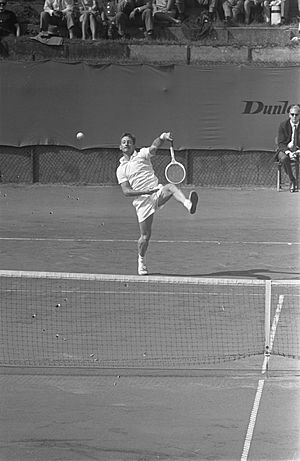
The Open Era (1968–1976)
The Open Era began in 1968. This meant professional players could finally compete in Grand Slam events again. Laver became Wimbledon's first Open Era champion in 1968. He beat Tony Roche in the final.
In 1969, Laver achieved something incredible. He won all four Grand Slam tournaments in the same year for the second time! This is still the only time a man has done this in the Open Era. He won 18 singles tournaments that year, which is an Open Era record. He won 106 matches and lost only 16. He won Wimbledon for the fourth time in a row that he entered.
Laver showed he could play well on any surface. He won Grand Slams on grass and clay. He also won important hard court and indoor tournaments. He was ranked number 1 in the world for 1969.
In the early 1970s, Laver played fewer Grand Slam tournaments. This was partly due to his contracts with different tennis tours. However, he remained a top player on the WCT tours. He also earned the most prize money.
In 1971, Laver won seven titles. He became the first tennis player to earn over $1 million in career prize money. In 1973, he helped Australia win the Davis Cup again. He won all six of his matches in the semifinals and final. In 1974, at 36 years old, he was ranked World No. 4. This made him the oldest player in the top five during the Open Era.
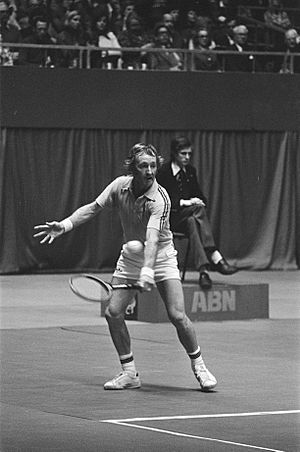
Laver mostly retired from the main tour in 1976. He still played some events. Overall, he won 74 singles titles in the Open Era. This is the seventh most of any player. He also won 37 doubles titles.
Friendly Rivalries
Rod Laver had many exciting rivalries with other great players.
- Ken Rosewall: He had a long and friendly rivalry with Ken Rosewall. They played over 130 matches as professionals. Laver won more of these matches.
- Pancho Gonzales: Against the older Pancho Gonzales, Laver won 43 out of 65 matches.
- Roy Emerson: Laver also had a long rivalry with fellow Australian Roy Emerson. Laver won 49 of their 67 matches.
- Arthur Ashe: Laver had a strong record against Arthur Ashe, winning 21 of their 24 matches.
- John Newcombe: Against John Newcombe, Laver led their matches 16 to 5.
Davis Cup Success
Laver was a key part of the Australian Davis Cup team. He helped Australia win the Davis Cup four years in a row, from 1959 to 1962. In 1973, professional players were allowed to play in the Davis Cup for the first time. Laver joined the team and helped Australia win for a fifth time. He won all his singles and doubles matches in the final. Australia won the Davis Cup every year Laver played in the competition.
Playing Style
Rod Laver was not very tall or big. However, he had a complete tennis game. He was known for his serve-and-volley style. He also hit powerful groundstrokes. His left-handed serve was tricky for opponents. He hit his groundstrokes with topspin, which was unusual for his time.
Laver was very fast on the court. He had a strong left forearm. This gave him great power and control. He was also excellent at the net, hitting strong volleys. He could adapt his game to any court surface or conditions. He was also known for winning long, five-set matches. He often changed his tactics to come back and win.
Rod Laver's Legacy
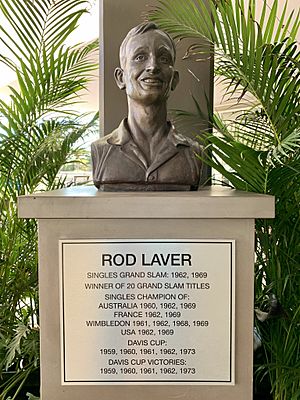
Many people believe Rod Laver is the greatest tennis player in history. He won six major titles as an amateur, including his first Grand Slam. Then, he turned professional and won eight professional major titles. After the Open Era began, he won five more major championships. This included his second Grand Slam. He is the only male singles player to win two Grand Slams. He is also the only male singles player to do so in the Open Era.
Laver won titles on all court surfaces of his time. He also helped Australia win five Davis Cup titles. The Rod Laver Arena and the Laver Cup tournament are named after him.
His record of 200 career singles titles is likely to stand forever. He also holds records for most titles in a single year in different eras. Many tennis experts, including former players and historians, praise Laver highly. In 2000, an Associated Press poll voted Laver "The Male Tennis Player of the Century." In 2017, Roger Federer, another tennis legend, called Rod Laver the greatest of all time.
Honours and Recognition
In 2000, the main court at Melbourne Park, where the Australian Open is held, was named the Rod Laver Arena in his honour. In 2016, he received a high honour, being appointed a Companion of the Order of Australia.
The tennis hall in Rockhampton, where Laver played as a child, was named the Rod Laver Hall in 1963. This was to celebrate his first Grand Slam win.
Laver has received many awards. He won the ABC Sportsman of the Year Award in 1969. He was inducted into the International Tennis Hall of Fame in 1981. He is also an Australian Living Treasure. In 1998, he received the Philippe Chatrier Award, the highest honour from the International Tennis Federation.
In 2005, Laver was named a Queensland Great. In 2009, he was named one of the Q150 Icons of Queensland. Bronze statues and busts of Laver have been placed in Melbourne Park and Rockhampton to celebrate his achievements.
| Member of the Order of the British Empire (MBE) | 1970 Queen's Birthday Honours – "For service to Tennis" | |
| Australian Sports Medal | 30 August 2000 – "Possibly the greatest player ever. The only player to capture two "Grand Slams"" | |
| Companion of the Order of Australia (AC) | 2016 Australia Day Honours – "For eminent service to tennis as a player, representative and mentor, at the national and international level, and as a role model for young sportsmen and women". |
Personal Life
On July 27, 1998, Rod Laver had a stroke. He recovered over the next year.
In 1966, Laver married Mary Benson. They had a son named Rick. Mary Laver passed away in November 2012. Since 2018, he has been living with his partner Susan Johnson.
Laver lives in Carlsbad, California. He was inducted into the Southern California Tennis Hall of Fame in 2017.
Images for kids
See also
 In Spanish: Rod Laver para niños
In Spanish: Rod Laver para niños


